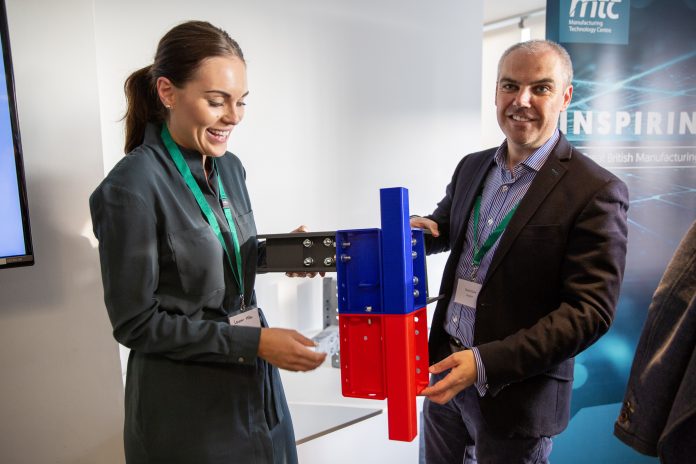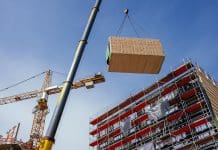Richard Crosby, director of construction consultants blacc, looks at how a pioneering consortium could transform the way schools are designed, procured and built offsite
In the 1970s, the US car industry was severely impacted by Japanese car manufacturers who had perfected a highly efficient production system. The US car manufacturers came together and collaborated to develop a standardised approach to aggregate demand and reduce cost.
We in the Seismic consortium identified a tremendous opportunity to adopt a similar collaborative approach to improve the efficiency of school construction.
Ambitious aims
School estates are often made up of mismatched, separate buildings developed over time to meet changes in demand, creating inefficient layouts. Every offsite manufacturer uses a different structural solution so new school buildings have to be redesigned every time to suit each system. Our view was this is an inefficient way of working.
The overriding aim of the Seismic project was to increase efficiency to reduce cost by standardising the offsite frame dimensions across the industry to create a componentised system for building new schools, beginning with primary facilities.
The aim was also to simplify the design process at the earliest stage – ensuring both feasibility and compliance with Department for Education (DfE) requirements in the most efficient way possible. Our solution would be to develop a digital version of the standardised DfE school clusters that would allow teaching professionals to assess if a compliant school building can fit on a specific site. This tool would use standard module sizes as a kit of parts for designing a school.
The project partners
All the partners involved in the project recognised its potential and each invested significant resources to ensure its success.
- The original concept was developed by blacc, which also provided project leadership expertise.
- The McAvoy Group and Elliott collaborated to standardise the structural components, with a view to expanding the market and de-risking offsite for clients. These partners worked very well together, successfully combining their offsite manufacturing expertise for the success of the project.
- The Manufacturing Technology Centre (MTC) coordinated the bid submission and acted as the catalyst to create the consortium. The MTC also gave the partners the opportunity to think beyond how schools have been delivered previously and apply more manufacturing principles to the construction of new schools, helping to develop more efficient processes.
- Bryden Wood provided digital expertise and led the development of the technology for the configurator.
The project was funded by UKRI through the Industrial Strategy Challenge Fund and Innovate UK.
How to achieve greater standardisation in school construction
Standardisation and volume are always key for efficient manufacturing. If processes are more efficient and there are fewer components, labour costs are reduced. This means the focus can be on the quality of the materials and achieving best value.
The standardised grid and connecting solution simplify the design process and enable the second part of the project – the configurator tool – that allows a non-construction professional to configure a fully DfE-compliant school on a specific site. The intention is to speed up the early feasibility process.
Offsite framing solution for schools
The starting point with the framing solution was to engineer a single, standardised way for The McAvoy Group and Elliott to interconnect their respective modular building systems. An engineered solution has been developed to connect each of the steel frames that make up a module – and to interconnect each module vertically and horizontally to make up a school building cluster.
The result is fewer welded joints and fewer connections – which in turn means less steel, less weight, faster assembly and therefore reduced cost. The frame solution has been standardised around the building clusters developed by the DfE. It has a single width and height, and three length options to suit school buildings – using the same engineered connection solution.
The principle of standardised, manufactured components is that greater volumes will drive down costs and simplify procurement. For example, the DfE can pre-order a series of modules from any manufacturer that will be available ‘off the shelf’ for faster-building assembly when a site receives planning.
The benefits: Productivity, cost and environmental
By rationalising the design of the steel frame, the number of components has been reduced. This means faster module assembly in the factory – increasing productivity by up to 50%. Work on-site to interconnect modules is also more efficient.
The partners’ research has shown that the new solution significantly reduces the number of frame components and will, therefore, use 25% less steel. The reductions in steel components and assembly time combine to generate a cost-saving for these elements of up to 25%.
With fewer components, the weight of the modules will reduce by 25% with no compromise on structural rigidity – generating 25% lower carbon emissions for the offsite construction of an average 40-module school. This is equivalent to over 155,000 miles of car driving or 17 flights from London to Sydney.
A unique approach to achieve unprecedented economies of scale
The intention is to offer the series of standardised components freely to the market, with the original design being subject to a patent application. Wide adoption will drive down the cost of the component manufacture and increase productivity across the offsite sector in education and other sectors.
This collaborative, standardised approach will make it easier for clients to procure offsite, for the supply chain to manufacture components and for offsite specialists increase to productivity.
The Seismic School Configurator
The team at Bryden Wood has developed a web app that encodes the spatial requirements alongside guidance for DfMA. Game engine technology was used to build the configurator and to make it as much like a computer game as possible. Games such as Minecraft provided inspiration for the look and feel – the team wanted it to be different to the costly, professional desktop software that architects normally use.
A web app rather than a desktop application was created so the configurator could be as open and widely available for users as possible. This is a tool which is useful for architects who are designing schools in a conventional way and it will also allow a larger group of stakeholders to get involved. Teachers, parents and pupils can potentially design their own school.
An open-source approach
The Seismic consortium has open-sourced the app in order to help build a development community around it so that the maintenance and updates can be a collective effort. It is compliant with DfE planning regulations and has been built so future regulatory changes can easily be incorporated to ensure it stays current and compliant.
The team wants to encourage as many people as possible to get involved. Open-sourcing technology is often disruptive – this approach lowers the barrier to entry and helps to democratise the design process.
As a result, better schools will be designed and delivered more efficiently. The team hopes that this app will encourage more designers to engage and use it to deliver their buildings.
The app can be accessed here.
Seismic: A powerful example to inspire other innovative projects
According to Sam Stacey, challenge director for Transforming Construction at UKRI: “The Seismic project is a powerful example that the targets set out in the Construction 2025 Strategy are achievable. It is one of the first Innovate UK projects under Transforming Construction to be completed and demonstrates that this level of collaboration is the future of construction.
“The Seismic initiative has been a tremendous success and it has hit all of the targets for Transforming Construction. The project partners have demonstrated an unprecedented level of collaboration, which we hope will inspire other forward-thinking projects to help innovate in construction and produce more efficient, sustainable and affordable buildings.
“The focus of Seismic was to realise the government’s ambition for greater productivity in construction and this has definitely been achieved with the offsite and digital solutions developed by the team. We are in no doubt that these innovations have the potential to change the way primary school projects are designed, procured and constructed, helping to meet the rising demand for school places and increase capacity in the construction industry.”
Next steps
The benefits are already being realised in new Department for Education procurement frameworks. The team is in the process of completing testing of the frame solution. The next stage is a collaboration with steel fabricators to develop the standardised components and establish a supply chain with a view to making these available to the offsite market in the coming months. This approach will aggregate demand to reduce cost.
The aim is to develop a ‘product family’ for different types of buildings, such as residential. The team also has aspirations to ‘componentise’ other parts of a school building to be able to offer a whole school solution, including walls and roofs.
For further information:
Blacc – Richard Crosby, richard@blacc.co
Elliott – James Cowell, james.cowell@elliottuk.com
The McAvoy Group – David Clark, davidclark@mcavoygroup.com
MTC – Susan Hone-Brookes, susan.hone-brookes@the-mtc.org
Bryden Wood – Jaimie Johnston, jjohnston@brydenwood.co.uk
Richard Crosby
Director
blacc/Seismic consortium
Tel: +44 (0)1422 749000














